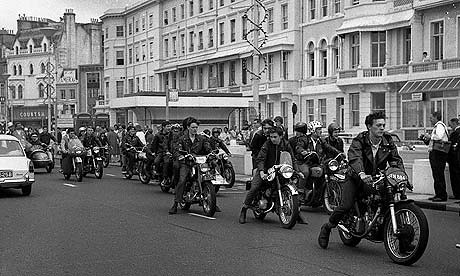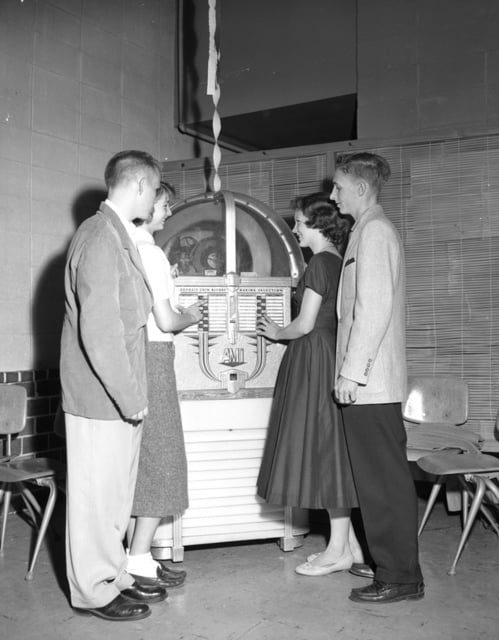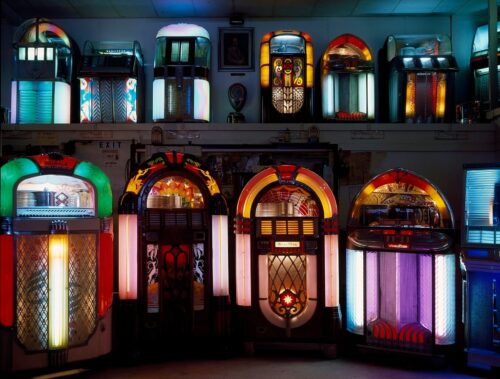Jukeboxes, those vibrant, glowing machines filled with vinyl records or digital tracks, are far more than nostalgic relics or mere music players. They are dynamic instruments of human expression, weaving together sound, emotion, and social interaction in ways that transcend ordinary communication. From covert messages exchanged between lovers in a dimly lit bar to subversive declarations of identity in a tense cultural clash, jukeboxes have served as a unique medium for connection, rebellion, and personal storytelling. This article explores the multifaceted ways jukeboxes function as the ultimate form of communication, delving into their role in secret messaging, subcultural rivalries, emotional expression, and even as symbols of status and success.
The Secret Language of Song Selection
Imagine a crowded bar in the 1950s, the air thick with cigarette smoke and the clink of glasses. Two lovers sit at opposite ends of the room, unable to speak openly due to prying eyes or social constraints. Instead, they communicate through the jukebox. She selects Ella Fitzgerald’s “My Funny Valentine,” a tender ballad that speaks of enduring love despite imperfections. He responds with Frank Sinatra’s “I’ve Got You Under My Skin,” a subtle declaration of passion. To onlookers, these are just songs, but to the couple, they are coded messages, carrying emotions too delicate or dangerous to voice aloud.
This practice of using jukeboxes to send secret messages was not uncommon. In settings like bars, cafes, or diners, where people gathered but privacy was scarce, the jukebox became a conduit for unspoken words. Songs were chosen not just for their melody but for their lyrics, titles, or cultural associations. A heartbroken patron might play Hank Williams’ “I’m So Lonesome I Could Cry” to signal their sorrow to a former lover across the room. A spy in a Cold War-era diner might select a seemingly innocuous tune like “Blue Moon” to signal a rendezvous to an ally. The jukebox allowed for plausible deniability—after all, who could prove the song was anything more than a casual choice?
The beauty of this communication lay in its subtlety and universality. Songs are inherently emotional, and their meanings can be layered, allowing senders and receivers to interpret them in deeply personal ways. Unlike a letter or a phone call, a jukebox selection was public yet private, a message hidden in plain sight. This made it ideal for lovers, friends, or even adversaries who needed to communicate without drawing attention.
Subcultural Rivalries: Teddy Boys vs. Mods
In the mid-20th century, jukeboxes became battlegrounds for cultural and subcultural expression, particularly in Britain during the 1950s and 1960s. The rivalry between the Teddy Boys and the Mods—two distinct youth subcultures—illustrates how jukeboxes served as platforms for asserting identity and sending pointed messages.
The Teddy Boys, with their Edwardian-inspired suits and love for rock ‘n’ roll, gravitated toward jukeboxes loaded with tracks by Elvis Presley, Chuck Berry, or Eddie Cochran. Their song choices were bold and rebellious, reflecting their defiance of post-war austerity and their embrace of American rock culture. A Teddy Boy dropping a coin into a jukebox to play “Hound Dog” wasn’t just enjoying music; he was staking a claim, signaling his allegiance to a lifestyle that valued flashiness and swagger.

Enter the Mods, a rival subculture with sharp suits, scooters, and a taste for soul, ska, and early British Invasion bands like The Who and The Small Faces. When Mods took over a cafe’s jukebox, they might select “My Generation” or a Motown hit like “Ain’t Too Proud to Beg,” deliberately contrasting the Teds’ rock ‘n’ roll with their own sophisticated, cosmopolitan sound. These choices weren’t random—they were provocations, a way to assert dominance in shared spaces like cafes or dance halls. A Mod playing a soul track in a Teddy Boy haunt was as much a challenge as a thrown punch, and vice versa.
This musical warfare extended beyond mere taste. Jukeboxes allowed these groups to communicate their values, mock their rivals, and claim territory without direct confrontation. The act of selecting a song was a performance, watched by peers and enemies alike, and the jukebox was the stage. In this way, jukeboxes became more than entertainment devices; they were tools for social maneuvering, allowing subcultures to define themselves and antagonize others through the universal language of music.
Subversive Expression: The Jukebox as Emotional Outlet
Beyond coded messages and subcultural rivalries, jukeboxes offered a platform for subversive emotional expression. In an era when societal norms often stifled open displays of feeling—particularly for marginalized groups—the jukebox provided a safe way to broadcast one’s inner world. A woman in the 1960s, constrained by expectations of demure behavior, might play Aretha Franklin’s “Respect” to assert her demand for dignity. A teenager grappling with alienation might choose The Rolling Stones’ “Paint It Black” to externalize their turmoil. These selections allowed individuals to express emotions that might otherwise be suppressed, using the jukebox as a proxy for their voice.
This subversive potential was especially powerful in contexts where direct communication was risky. During the Civil Rights Movement in the United States, for example, African American patrons in segregated diners might play Sam Cooke’s “A Change Is Gonna Come” on a jukebox, a song that resonated as both a lament and a call for justice. The act was subtle but defiant, a way to assert hope and resistance in a space where open protest could invite danger. Similarly, in conservative small towns, a queer individual might select a song like Judy Garland’s “Over the Rainbow” to hint at their identity or longing, knowing that only those attuned to the subtext would understand.
The jukebox’s public nature amplified its subversive power. Unlike a diary or a whispered confession, a song played for all to hear could reach an audience, creating a shared moment of understanding or provocation. Yet, because the message was cloaked in music, it remained ambiguous enough to avoid immediate repercussions. This balance of visibility and deniability made the jukebox a uniquely effective tool for emotional and political expression.
A Statement of Success: The Jukebox as Status Symbol
Owning a jukebox, whether in a home, bar, or private club, has long been a marker of success and cultural capital. In the mid-20th century, jukeboxes were expensive, technologically sophisticated machines, and possessing one signaled financial stability and a connection to the pulse of popular culture. For a bar owner in the 1950s, a gleaming Wurlitzer or Seeburg jukebox was not just a source of revenue but a statement of modernity and relevance, drawing crowds eager to engage with the latest hits. Similarly, a wealthy individual who installed a jukebox in their home was showcasing their ability to afford luxury and their taste for music as a form of entertainment.
Even today, vintage jukeboxes are prized collectibles, often costing thousands of dollars to restore or purchase. Owning one is a declaration of nostalgia, wealth, and individuality—a way to say, “I have the means to preserve a piece of history.” Modern digital jukeboxes, like those from TouchTunes, carry a similar cachet in commercial settings, signaling that a venue is trendy and tech-savvy. The jukebox, in this sense, communicates not just through the music it plays but through its very presence, broadcasting the owner’s status to all who see it.
The Social Hub of the Jukebox

Jukeboxes are inherently communal. Unlike a personal radio or a streaming playlist, they invite participation from everyone in a space. In a bar or cafe, patrons take turns selecting songs, creating a collective soundtrack that reflects the mood of the room. This shared experience fosters a form of communication that is both democratic and dynamic. A group of friends might debate over which song to play, each choice revealing something about their personality or priorities. A stranger’s selection might spark a conversation, turning a solitary moment into a social one.
This communal aspect also amplifies the jukebox’s role as a cultural mirror. In the 1950s, a jukebox stocked with rock ‘n’ roll and rhythm and blues reflected the growing influence of youth culture and racial integration in music. In the 1980s, one filled with synth-pop and hair metal captured the era’s excess and rebellion. Today, digital jukeboxes with vast catalogs allow patrons to curate highly personal selections, from obscure indie tracks to global pop hits, reflecting the diversity and individuality of modern society.
The Enduring Legacy of Jukebox Communication
In an age of smartphones and streaming services, the jukebox might seem like a quaint anachronism, but its communicative power endures. Modern digital jukeboxes, accessible via apps or touchscreens, allow users to queue songs remotely, continuing the tradition of sending messages through music. A college student might dedicate a song to a crush across a crowded bar, just as lovers did decades ago. A group of friends might playfully compete to control the playlist, their choices a form of banter or bonding. Even in private homes, restored vintage jukeboxes or modern replicas serve as conversation pieces, sparking stories and connections among guests.
The jukebox’s ability to communicate lies in its fusion of music, emotion, and social context. It transforms a simple act—dropping a coin or tapping a screen—into a statement, a confession, or a challenge. Whether it’s lovers exchanging coded messages, rivals asserting their identity, individuals expressing suppressed emotions, or owners flaunting their success, the jukebox amplifies human connection in ways that few other mediums can match. It is a machine that sings not just songs but stories, making it the ultimate form of communication.
Jukebox Buyer Resources
Jukebox Auctions – Vinyl Record Jukeboxes – CD Jukeboxes – Jukebox Records

